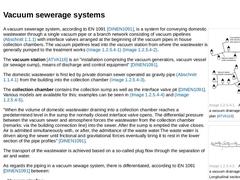
|
| (Image: Arrangement of a vacuum drainage system - Site plan [ATVA116]) | | (Image: Arrangement of a vacuum drainage system - Longitudinal section [DINEN1091]) | | (Image: Diagram of a house connection in a vacuum drainage system [DINEN1091]) | | (Image: Forms of collecting chambers [DINEN1091] - With sump capacity provided in feed pipework) | | (Image: Forms of collecting chambers [DINEN1091] - With separate collection chamber and valve pit) |
A vacuum sewerage … |
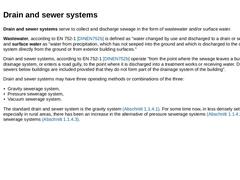
|
Drain and sewer systems serve to collect and discharge sewage in the form of wastewater and/or surface water. Wastewater, according to EN 752-1 [DINEN752b] is defined as "water changed by use and discharged to a drain or sewer system" and surface water as "water from precipitation, which has not seeped into the ground and which is discharged to the drain or sewer system directly from the ground or from exterior building surfaces." Drain and sewer systems, … |
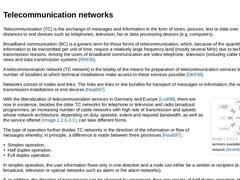
|
Telecommunication (TC) is the exchange of messages and information in the form of tones, pictures, text or data over larger distances to end devices such as telephones, television, fax or data processing devices (e.g. computers). Broadband communication (BC) is a generic term for those forms of telecommunication, which, because of the quantity of information to be transmitted per unit of time, require a relatively large frequency land (mostly several … |
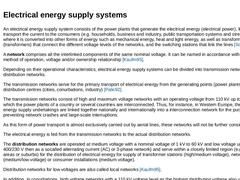
|
An electrical energy supply system consists of the power plants that generate the electrical energy (electrical power), lines that transport the current to the consumers (e.g. households, business and industry, public transportation systems and street lighting), where it is converted into other forms of energy such as mechanical energy, heat and light energy, as well as transformer stations (transformers) that connect the different voltage levels … |
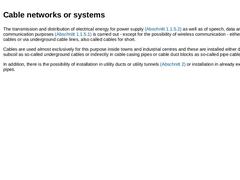
|
The transmission and distribution of electrical energy for power supply (Abschnitt 1.1.5.2) as well as of speech, data and pictures for communication purposes (Abschnitt 1.1.5.1) is carried out - except for the possibility of wireless communication - either via overhead cables or via underground cable lines, also called cables for short. Cables are used almost exclusively for this purpose inside towns and industrial centres and these are installed … |
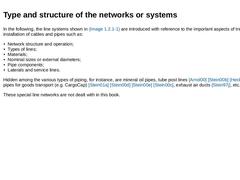
|
In the following, the line systems shown in Bild 1 are introduced with reference to the important aspects of trenchless installation of cables and pipes such as: - Network structure and operation;
- Types of lines;
- Materials;
- Nominal sizes or external diameters;
- Pipe components;
- Laterals and service lines.
Hidden among the various types of piping, for instance, are mineral oil pipes, tube post lines [Arnol00] [Stein00b] [Heck65] transport pipes for goods … |
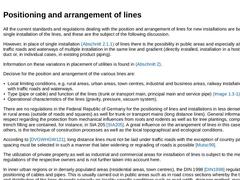
|
All the current standards and regulations dealing with the position and arrangement of lines for new installations are based on the single installation of the lines, and these are the subject of the following discussion. However, in place of single installation (Abschnitt 2.1.1) of lines there is the possibility in public areas and especially at crossings of traffic roads and waterways of multiple installation in the same line and gradient (directly … |
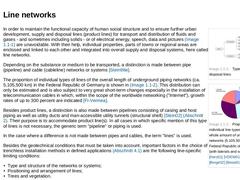
|
| (Image: Types of supply and disposal lines) | | (Image: Proportion of individual line types (in km) of the whole amount of underground networks (5.105.500 km) in the Federal Republic of Germany (with laterals and service lines [Herz01] [VDEW01] [FI-Telek01] [Berge02] [Besie01])) |
In order to maintain the functional capacity of human social structure and to ensure further urban development, supply and disposal lines (product lines) for transport and … |
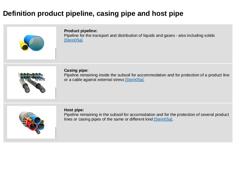
|

|
(Image: Product pipes [FI-Steina])
Product pipeline:
Pipeline for the transport and distribution of liquids and gases - also including solids [Stein05a]. |
|
(Image: Casing pipes [FI-Steina])
Casing pipe:
Pipeline remaining inside the subsoil for accommodation and for protection of a product line or a cable against external stress [Stein05a]. |
|
(Image: Bundled installation inside the host pipe [FI-Steina])
Host pipe:
Pipeline remaining in the subsoil … |
|
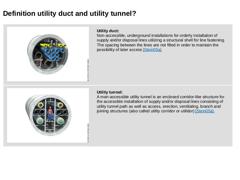
|

|
(Image: Utility duct)
Utility duct:
Non-accessible, underground installations for orderly installation of supply and/or disposal lines utilizing a structural shell for line fastening. The spacing between the lines are not filled in order to maintain the possibility of later access [Stein05a]. |
|
(Image: Man-accessible utility tunnel [FI-Steina])
Utility tunnel:
A man-accessible utility tunnel is an enclosed corridor-like structure for the accessible … |
|